Abstract
Using animal models of acinar and ductal pancreatic cancer, we investigated the effect of analogs of hypothalamic hormones on tumor growth. In Wistar/Lewis rats bearing the acinar pancreatic tumor DNCP-322, chronic administration of [L-5-Br-Trp8]somatostatin-14 significantly decreased tumor weights and volume. Somatostatin-28 and the cyclic hexapeptide analog of somatostatin cyclo(Pro-Phe-D-Trp-Lys-Thr-Phe) failed to influence the growth of this tumor. The agonistic analog of luteinizing hormone-releasing hormone [D-Trp6]LH-RH also significantly decreased tumor weight and volume in this model and reduced testosterone levels and the weights of the ventral prostate and tests. In Syrian hamsters bearing ductal type of pancreatic carcinoma, chronic administration of [L-5-Br-Trp8]somatostatin diminished tumor weights and volume. The percentage change in tumor volume was significantly decreased when compared to control animals. In one experiment, cyclic hexapeptide of somatostatin also inhibited growth of this tumor. [D-Trp6]LH-RH, given twice daily or injected in the form of microcapsules for constant controlled release, significantly decreased tumor weight and volume and suppressed serum testosterone levels. Hamsters castrated 4 days after transplantation of the pancreatic tumors showed a significant decrease in weight and volume of these tumors. This suggests that pancreatic cancers may, at least in part, be sex hormone sensitive. [D-Trp6]LH-RH may decrease the growth of pancreatic carcinomas by suppressing androgens. Somatostatin analogs reduce the growth of pancreatic ductal and acinar cancers, probably by inhibiting the release or stimulatory action of gastrointestinal hormones on tumor cells (or both). Inhibition of animal models of pancreatic tumors by chronic administration of somatostatin analogs and [D-Trp6]LH-RH suggests that these compounds should be considered for the development of a new hormonal therapy for cancer of the pancreas.
Full text
PDF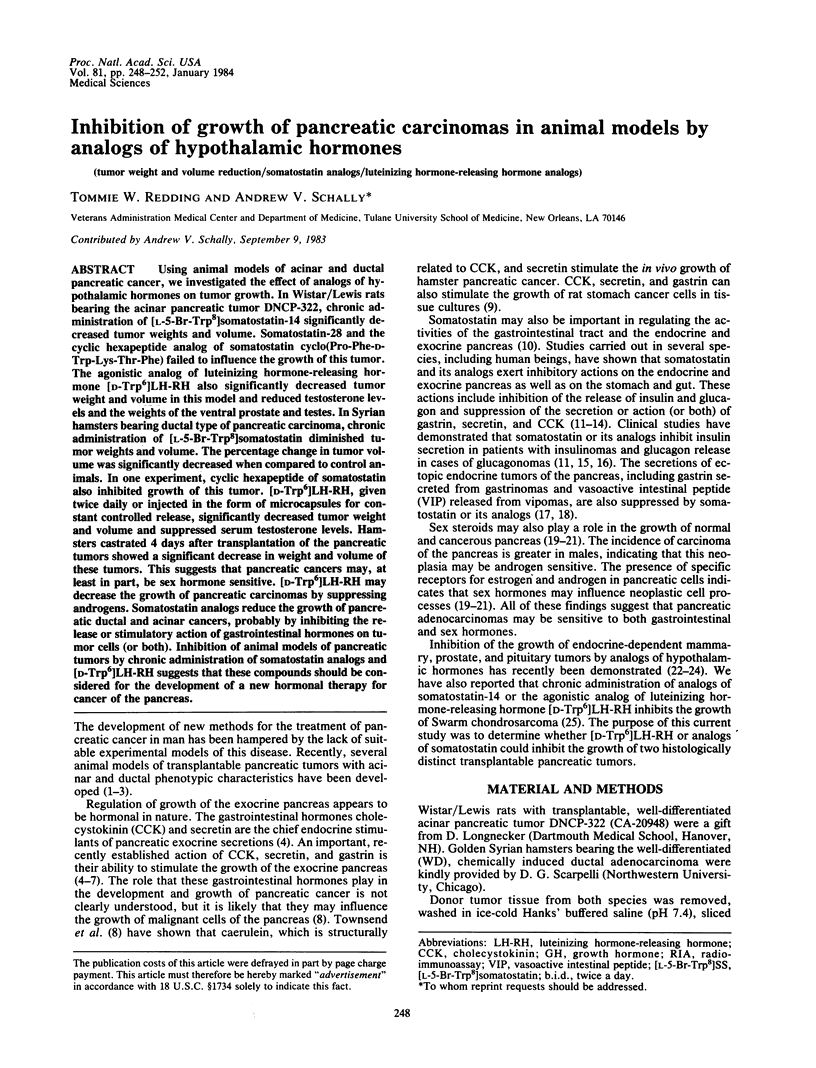
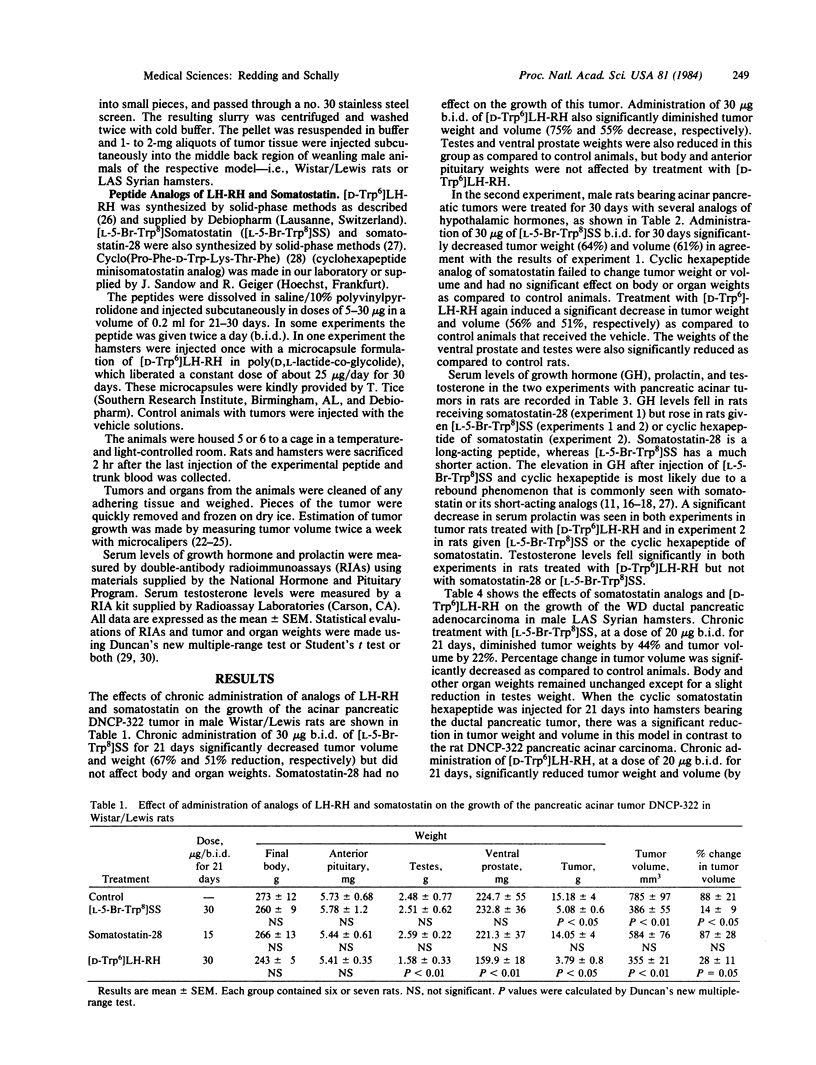
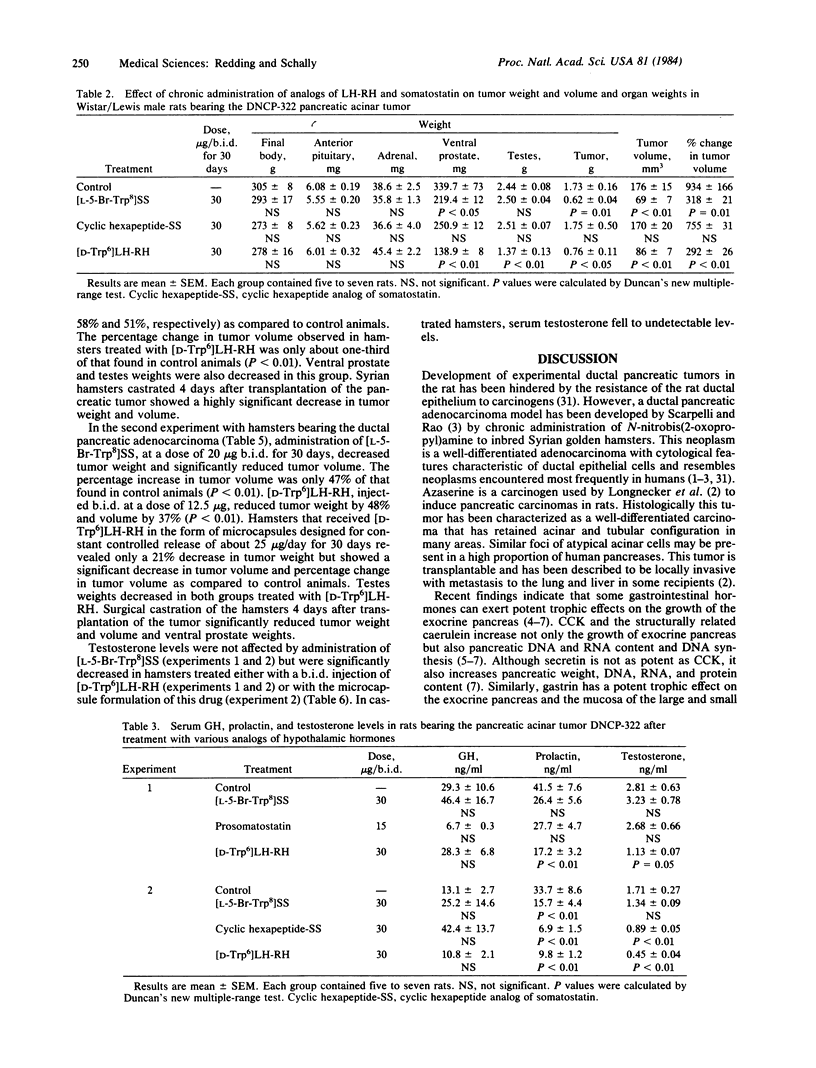
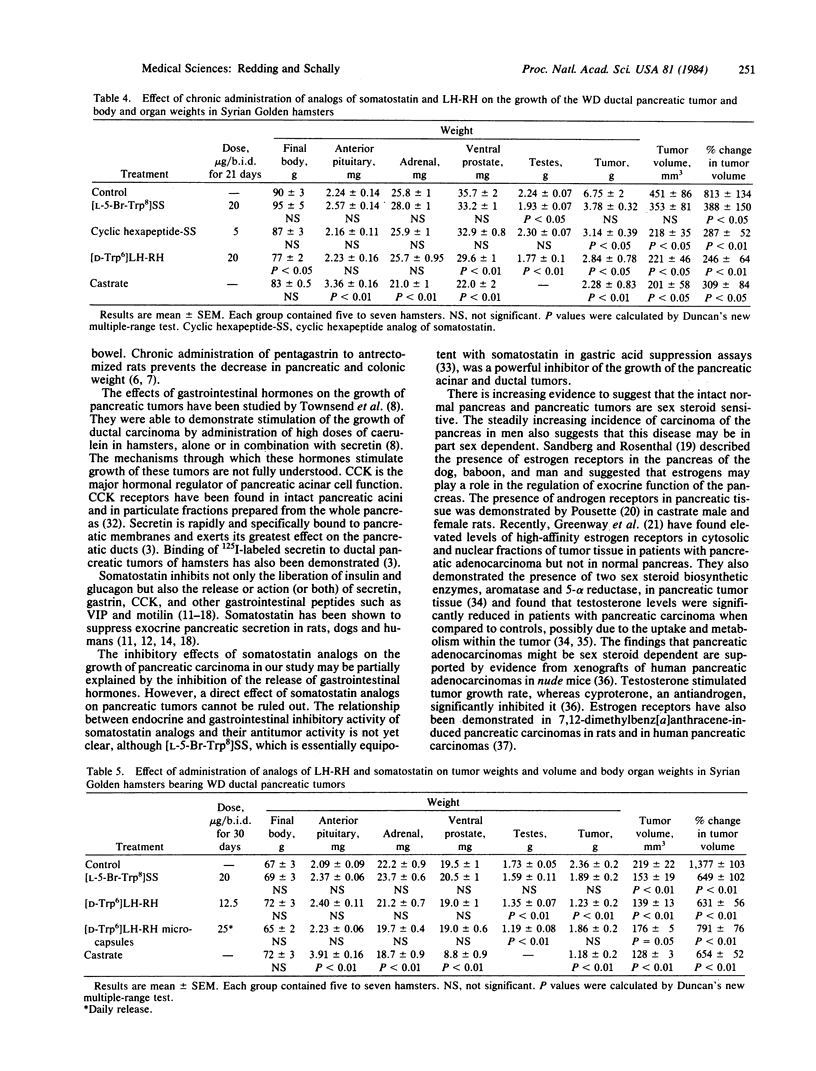
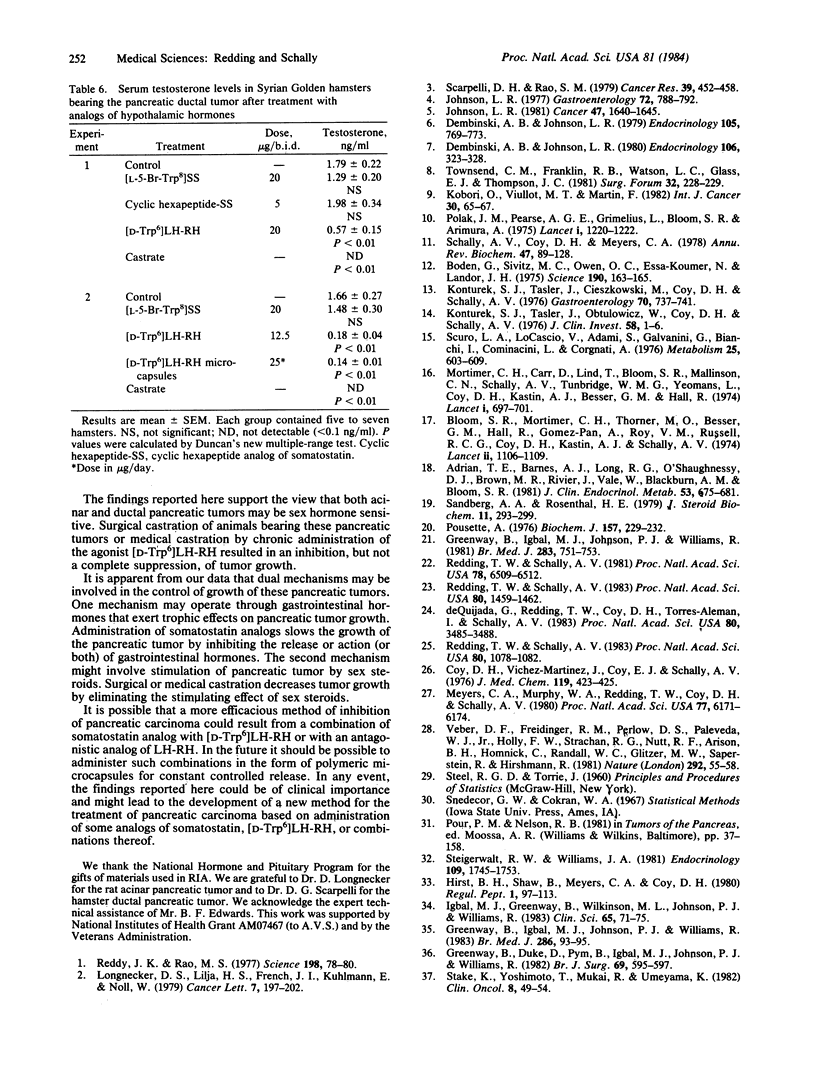
Selected References
These references are in PubMed. This may not be the complete list of references from this article.
- Adrian T. E., Barnes A. J., Long R. G., O'Shaughnessy D. J., Brown M. R., Rivier J., Vale W., Blackburn A. M., Bloom S. R. The effect of somatostatin analogs on secretion of growth, pancreatic, and gastrointestinal hormones in man. J Clin Endocrinol Metab. 1981 Oct;53(4):675–681. doi: 10.1210/jcem-53-4-675. [DOI] [PubMed] [Google Scholar]
- Bloom S. R., Mortimer C. H., Thorner M. O., Besser G. M., Hall R., Gomez-Pan A., Roy V. M., Russell R. C., Coy D. H., Kastin A. J. Inhibition of gastrin and gastric-acid secretion by growth-hormone release-inhibiting hormone. Lancet. 1974 Nov 9;2(7889):1106–1109. doi: 10.1016/s0140-6736(74)90869-1. [DOI] [PubMed] [Google Scholar]
- Boden G., Sivitz M. C., Owen O. E., Essa-Koumar N., Landor J. H. Somatostatin suppresses secretin and pancreatic exocrine secretion. Science. 1975 Oct 10;190(4210):163–165. doi: 10.1126/science.1166308. [DOI] [PubMed] [Google Scholar]
- Coy D. H., Vilchez-Martinez J. A., Coy E. J., Schally A. V. Analogs of luteinizing hormone-releasing hormone with increased biological activity produced by D-amino acid substitutions in position 6. J Med Chem. 1976 Mar;19(3):423–425. doi: 10.1021/jm00225a018. [DOI] [PubMed] [Google Scholar]
- Dembinski A. B., Johnson L. R. Growth of pancreas and gastrointestinal mucosa in antrectomized and gastrin-treated rats. Endocrinology. 1979 Sep;105(3):769–773. doi: 10.1210/endo-105-3-769. [DOI] [PubMed] [Google Scholar]
- Dembinski A. B., Johnson L. R. Stimulation of pancreatic growth by secretin, caerulein, and pentagastrin. Endocrinology. 1980 Jan;106(1):323–328. doi: 10.1210/endo-106-1-323. [DOI] [PubMed] [Google Scholar]
- Greenway B., Duke D., Pym B., Iqbal M. J., Johnson P. J., Williams R. The control of human pancreatic adenocarcinoma xenografts in nude mice by hormone therapy. Br J Surg. 1982 Oct;69(10):595–597. doi: 10.1002/bjs.1800691013. [DOI] [PubMed] [Google Scholar]
- Greenway B., Iqbal M. J., Johnson P. J., Williams R. Low serum testosterone concentrations in patients with carcinoma of the pancreas. Br Med J (Clin Res Ed) 1983 Jan 8;286(6359):93–95. doi: 10.1136/bmj.286.6359.93. [DOI] [PMC free article] [PubMed] [Google Scholar]
- Greenway B., Iqbal M. J., Johnson P. J., Williams R. Oestrogen receptor proteins in malignant and fetal pancreas. Br Med J (Clin Res Ed) 1981 Sep 19;283(6294):751–753. doi: 10.1136/bmj.283.6294.751. [DOI] [PMC free article] [PubMed] [Google Scholar]
- Hirst B. H., Shaw B., Meyers C. A., Coy D. H. Structure-activity studies with somatostatin: the role of tryptophan in position 8. Regul Pept. 1980 Oct;1(2):97–113. doi: 10.1016/0167-0115(80)90014-2. [DOI] [PubMed] [Google Scholar]
- Iqbal M. J., Greenway B., Wilkinson M. L., Johnson P. J., Williams R. Sex-steroid enzymes, aromatase and 5 alpha-reductase in the pancreas: a comparison of normal adult, foetal and malignant tissue. Clin Sci (Lond) 1983 Jul;65(1):71–75. doi: 10.1042/cs0650071. [DOI] [PubMed] [Google Scholar]
- Johnson L. R. Effects of gastrointestinal hormones on pancreatic growth. Cancer. 1981 Mar 15;47(6 Suppl):1640–1645. doi: 10.1002/1097-0142(19810315)47:6+<1640::aid-cncr2820471430>3.0.co;2-s. [DOI] [PubMed] [Google Scholar]
- Johnson L. R. New aspects of the trophic action of gastrointestinal hormones. Gastroenterology. 1977 Apr;72(4 PT2):788–792. [PubMed] [Google Scholar]
- Kobori O., Vuillot M. T., Martin F. Growth responses of rat stomach cancer cells to gastro-entero-pancreatic hormones. Int J Cancer. 1982 Jul 15;30(1):65–67. doi: 10.1002/ijc.2910300112. [DOI] [PubMed] [Google Scholar]
- Konturek S. J., Tasler J., Cieszkowski M., Coy D. H., Schally A. V. Effect of growth hormone release-inhibiting hormone on gastric secretion, mucosal blood flow, and serum gastrin. Gastroenterology. 1976 May;70(5 PT1):737–741. [PubMed] [Google Scholar]
- Konturek S. J., Tasler J., Obtulowicz W., Coy D. H., Schally A. V. Effect of growth hormone-release inhibiting hormone on hormones stimulating exocrine pancreatic secretion. J Clin Invest. 1976 Jul;58(1):1–6. doi: 10.1172/JCI108438. [DOI] [PMC free article] [PubMed] [Google Scholar]
- Longnecker D. S., Lilja H. S., French J., Kuhlmann E., Noll W. Transplantation of azaserine-induced carcinomas of pancreas in rats. Cancer Lett. 1979 Aug;7(4):197–202. doi: 10.1016/s0304-3835(79)80080-4. [DOI] [PubMed] [Google Scholar]
- Meyers C. A., Murphy W. A., Redding T. W., Coy D. H., Schally A. V. Synthesis and biological actions of prosomatostatin. Proc Natl Acad Sci U S A. 1980 Oct;77(10):6171–6174. doi: 10.1073/pnas.77.10.6171. [DOI] [PMC free article] [PubMed] [Google Scholar]
- Mortimer C. H., Tunbridge W. M., Carr D., Yeomans L., Lind T., Coy D. H., Bloom S. R., Kastin A., Mallinson C. N., Besser G. M. Effects of growth-hormone release-inhibiting hormone on circulating glucagon, insulin, and growth hormone in normal, diabetic, acromegalic, and hypopituitary patients. Lancet. 1974 Apr 20;1(7860):697–701. doi: 10.1016/s0140-6736(74)92903-1. [DOI] [PubMed] [Google Scholar]
- Polak J. M., Pearse A. G., Grimelius L., Bloom S. R. Growth-hormone release-inhibiting hormone in gastrointestinal and pancreatic D cells. Lancet. 1975 May 31;1(7918):1220–1222. doi: 10.1016/s0140-6736(75)92198-4. [DOI] [PubMed] [Google Scholar]
- Pousette A. Demonstration of an androgen receptor in rat pancreas. Biochem J. 1976 Jul 1;157(1):229–232. doi: 10.1042/bj1570229. [DOI] [PMC free article] [PubMed] [Google Scholar]
- Redding T. W., Schally A. V. Inhibition of growth of the transplantable rat chondrosarcoma by analogs of hypothalamic hormones. Proc Natl Acad Sci U S A. 1983 Feb;80(4):1078–1082. doi: 10.1073/pnas.80.4.1078. [DOI] [PMC free article] [PubMed] [Google Scholar]
- Redding T. W., Schally A. V. Inhibition of mammary tumor growth in rats and mice by administration of agonistic and antagonistic analogs of luteinizing hormone-releasing hormone. Proc Natl Acad Sci U S A. 1983 Mar;80(5):1459–1462. doi: 10.1073/pnas.80.5.1459. [DOI] [PMC free article] [PubMed] [Google Scholar]
- Redding T. W., Schally A. V. Inhibition of prostate tumor growth in two rat models by chronic administration of D-Trp6 analogue of luteinizing hormone-releasing hormone. Proc Natl Acad Sci U S A. 1981 Oct;78(10):6509–6512. doi: 10.1073/pnas.78.10.6509. [DOI] [PMC free article] [PubMed] [Google Scholar]
- Reddy J. K., Rao M. S. Transplantable pancreatic carcinoma of the rat. Science. 1977 Oct 7;198(4312):78–80. doi: 10.1126/science.897688. [DOI] [PubMed] [Google Scholar]
- Sandberg A. A., Rosenthal H. E. Steroid receptors in exocrine glands: the pancreas and prostate. J Steroid Biochem. 1979 Jul;11(1A):293–299. doi: 10.1016/0022-4731(79)90311-x. [DOI] [PubMed] [Google Scholar]
- Satake K., Yoshimoto T., Mukai R., Umeyama K. Estrogen receptors in 7,12-dimethylbenz (a) anthracene (DMBA) induced pancreatic carcinoma in rats and in human pancreatic carcinoma. Clin Oncol. 1982 Mar;8(1):49–54. [PubMed] [Google Scholar]
- Scarpelli D. G., Rao M. S. Transplantable ductal adenocarcinoma of the Syrian hamster pancreas. Cancer Res. 1979 Feb;39(2 Pt 1):452–458. [PubMed] [Google Scholar]
- Schally A. V., Coy D. H., Meyers C. A. Hypothalamic regulatory hormones. Annu Rev Biochem. 1978;47:89–128. doi: 10.1146/annurev.bi.47.070178.000513. [DOI] [PubMed] [Google Scholar]
- Scuro L. A., Lo Cascio V., Adami S., Galvanini G., Bianchi I., Cominacini L., Corgnati A. Somatostatin inhibition of insulin secretion in insulin-producing tumors. Metabolism. 1976 Jun;25(6):603–609. doi: 10.1016/0026-0495(76)90056-1. [DOI] [PubMed] [Google Scholar]
- Steigerwalt R. W., Williams J. A. Characterization of cholecystokinin receptors on rat pancreatic membranes. Endocrinology. 1981 Nov;109(5):1746–1753. doi: 10.1210/endo-109-5-1746. [DOI] [PubMed] [Google Scholar]
- Veber D. F., Freidlinger R. M., Perlow D. S., Paleveda W. J., Jr, Holly F. W., Strachan R. G., Nutt R. F., Arison B. H., Homnick C., Randall W. C. A potent cyclic hexapeptide analogue of somatostatin. Nature. 1981 Jul 2;292(5818):55–58. doi: 10.1038/292055a0. [DOI] [PubMed] [Google Scholar]
- de Quijada M. G., Redding T. W., Coy D. H., Torres-Aleman I., Schally A. V. Inhibition of growth of a prolactin-secreting pituitary tumor in rats by analogs of luteinizing hormone-releasing hormone and somatostatin. Proc Natl Acad Sci U S A. 1983 Jun;80(11):3485–3488. doi: 10.1073/pnas.80.11.3485. [DOI] [PMC free article] [PubMed] [Google Scholar]


